Week 6 December 10 - 15 2007 Two Strings Deployed

Christchurch Botanical Gardens.
I've just got back from a walk in the Christchurch Botanical Gardens, one of the best botanical gardens in the world. My opinion might be biased by the fact that it is usually the first green space I spend time in when I get off the ice. After sleeping in and taking a leisurely shower I had lunch at the Dux Delux and then went for my walk. The culture shock getting back isnÕt as strong as after a full season - after working through the January grind when the season feels like it will go on for ever. But it still gives you the heightened senses when warm moist air, and the feeling of lightness from not wearing heavy clothing, feels very special.
The last week at Pole was dominated by the successful deployment of 2 new strings in the IceCube detector, and the filling of IceTop detector tanks. I explained in detail in previous years emails how the IceCube detector works. IÕll give the very high level over view. IceCube is a high energy particle telescope, specifically looking for neutrinos. Neutrinos can not be detected directly, and instead we look for another particle, a muon, which is produced when a neutrino interacts in the nucleus of an atom. The muon is a charged particle traveling at the same speed of light as the neutrino that produced it Š the speed of light in a vacuum. When this muon is in the ice it needs to slow down to the speed of light in ice, and this happens by loosing energy by emitting radiation, Cherenkov radiation. This very faint glow is how we detect the muon in the very dark clear ice deep in the ice sheet. The trick is that this interaction is extremely rare and we need a massive volume of ice to detect many neutrinos.
IceCube will consist of 80 detector strings, each with 60 light detectors on each string. The detectors are evenly spaced over the last 1km of the string, and the top detector is 1.5km below the surface. What I havenÕt described before is how the detectors are put in the ice. The goal is to deploy 2 strings or better a week. Every few days a hole has to be drilled 2.5km deep in the ice and the cable lowered into the hole with the light detectors being attached as the string is lowered.
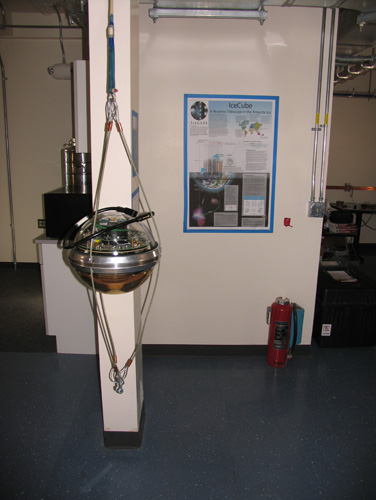
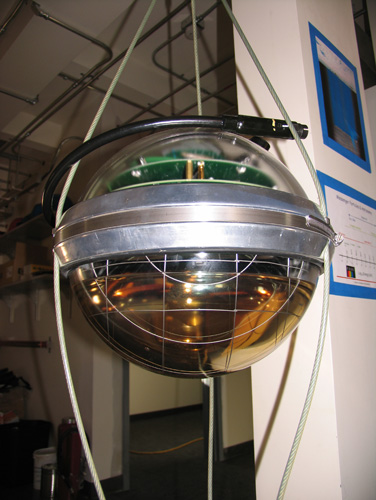
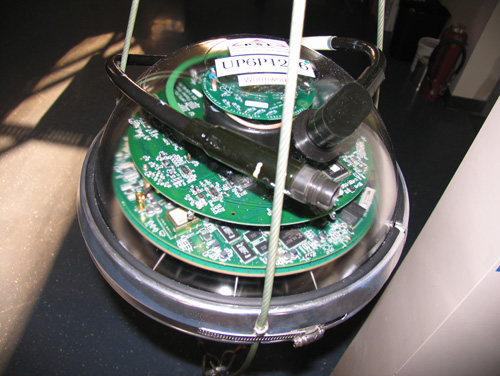
The Digital Optical Module, more commonly known as a DOM.
The hole is drilled using a high pressure hot water drill. The hot water for the drill is produced using large water heaters, highly tuned water heaters used in car washes, as many as 40 of them producing up to 4.7 megawatts of thermal power! This enormous amount of power is required to drill a hole in the ice about 60cm (2 feet) across and 2.5km deep in less than 2 days. Once the drill reaches the bottom of the hole it is now full of water which immediately starts to refreeze. On average of 4800 gallons of fuel is used to drill one hole. The drill makes the hole larger as it comes back to the surface, but once removed the hole has a life time of about 24 hours for deployment of the detector string before it has refrozen to the point where the modules will not fit into the hole.
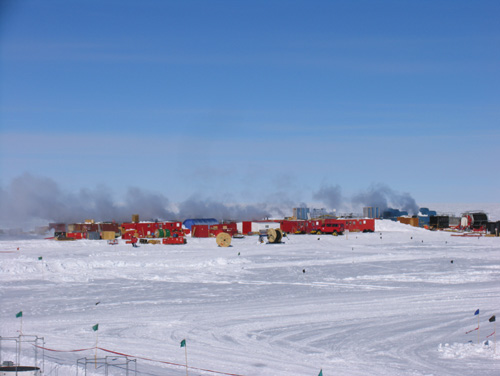
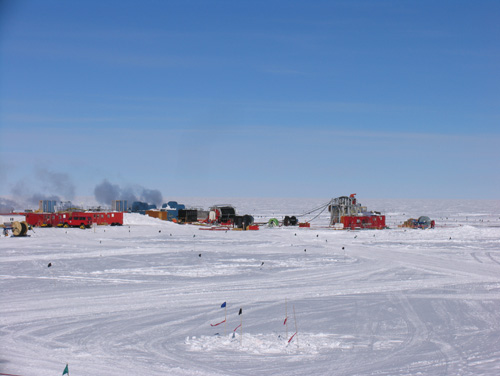
IceCube Drill Camp
The water in the hole is only contained to about 60m from the surface. Near the surface the snow has not compressed to solid ice and is called firn. The water in the hole can leak into the firn and be lost. Also water is unusual in that ice is less dense than liquid water. The water level will thus drop in the hole as the ice is melted. To make up for this water is added from another water well maintained for supplying the drill. Everything that goes into the hole, especially the light detector modules, needs to be able to withstand the pressure from the huge water column. In the case of the modules they also need to be able to withstand the freezing pressures. The modules are thus constructed of thick glass pressure vessels which can withstand 10000psi.
The drill system is very complex. The main 2.5km hose, and hose reel, that supplies the water to the drill head is in itself an large engineering project. Then there are the computer control systems that continually monitor all the systems and how they are interacting always looking for problems. The drill is operated around the clock by 3 shifts of drillers of about 12 people per shift. Once a hole is drilled the drillers immediately move the hose and reel to another tower site to start the next hole while the deployment team installs the string.
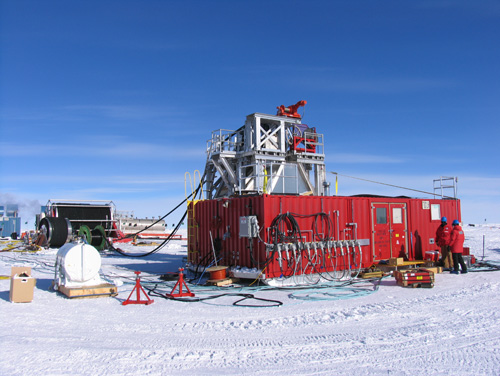

Tower Operations Site with the tower and hose reel.
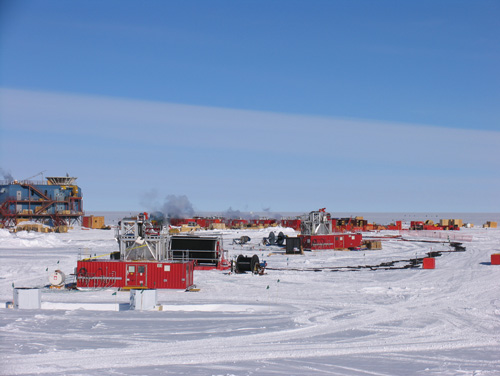
Tower sites being leap frogged.
Last season 13 strings were deployed. The system has been significantly improved since then and it is hoped that at least 14 strings are deployed this year, and if all went very well maybe as many as 18. This will take IceCube to close to half completed. 2 down!
The end of the season came quickly. I felt like I was running around trying to get work done, which was never ending. I had my little personal projects to finish, cards to write, and photos to take. The day before we were scheduled to leave there was to be a DV (Distringuished Visitor) visit. Weather caused it to be delayed a week. I was anxious to be available to talk to the NSF director of Cyberinfrastrucutre. I asked about the possibility of staying for the day and taking the same flight out as the DVs. I was told that was fine, but I was risking my other flights north. The weather wasnÕt looking good. But I figured the risk was low as they wouldnÕt want the DVs to get stuck, and theyÕd probably hold the C-17 flight for them if they did. On Thursday morning the weather was terrible, and I decided to go out on the first flight mostly because I decided that if the DVs did arrive they would get a punctuated tour anyway. As it turned out the plane landed in the worst conditions IÕve seen a landing in at Pole. IÕm told in the Navy days this wasnÕt unusual. The DVs got a 30 minute tour of the South Pole.

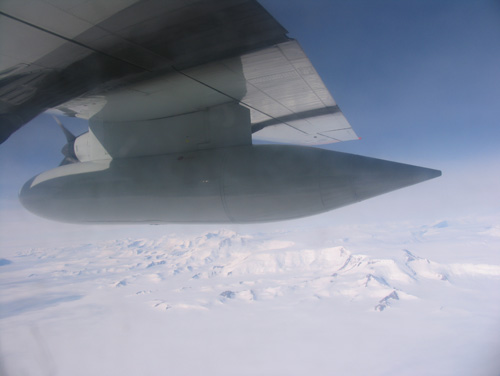

Flight from South Pole to McMurdo
Except for loosing one of my bags, which has never happened to me before, the trip out was uneventful. I had planned to take some stereo photos in McMurdo if I had time. I had time but my camera was in the bag which got delayed at Pole. So I spent the time catching up on work email. I had no motivation for sight seeing. I managed to prove my theory about there being no bad seats on a C-17 wrong. It was extreme bad luck, a crowded flight. Still not near as bad as many other flights IÕve had, and probably better then the commercial flight back to the US will be. Got back to roughing it at the Heritage Hotel by midnight.
It was a short season. I guess that is all I want to do these days but it does rob the season of any finality. I was concerned by the amount of work still to be done before I left. I have a very good team working there for the remainder of the season and IÕm sure they will complete the work competently. IÕm not used to working that way. I like to see the job done through to the end. There goes Antarctica making me make trade offs again. Who knows what Antarctica has installed for me in the future.
The End.

